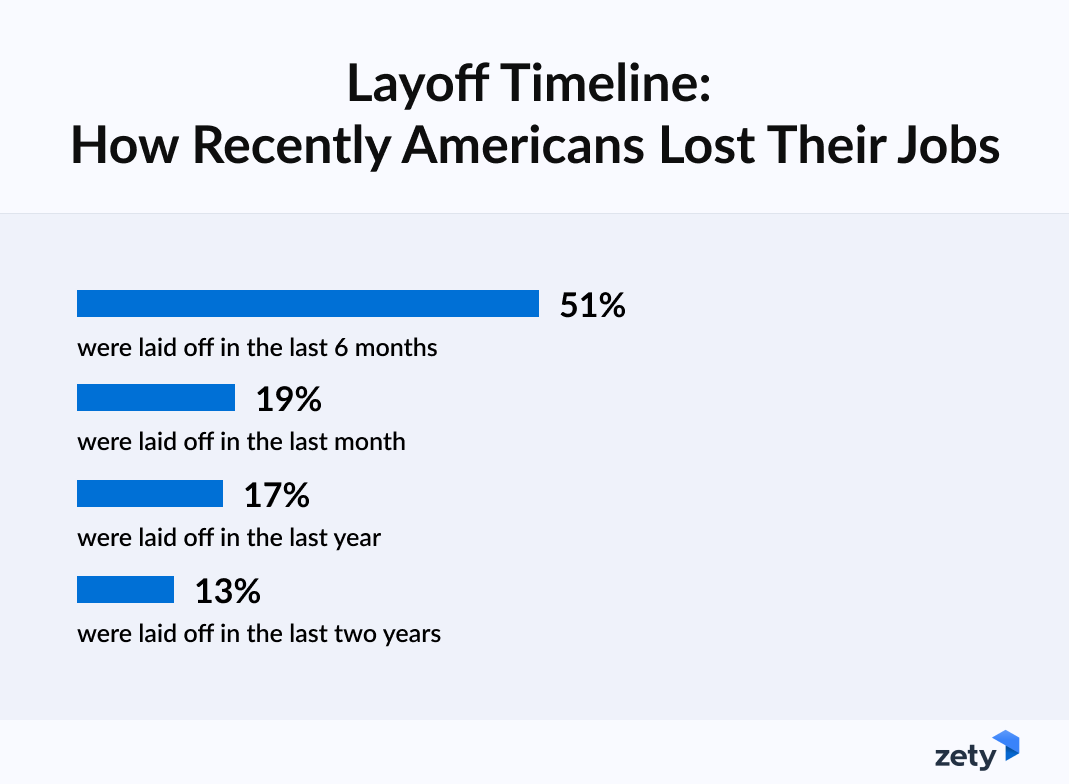
Job loss isn’t just hitting hard—it’s hitting cold. Zety’s 2025 Layoff Experience Report surveyed over 1,000 laid-off U.S. workers and found that many not only lost their jobs suddenly, but were informed in some of the most impersonal ways possible. From email notifications to silent system shutdowns, the data pulls back the curtain on how companies are letting people go—and how it’s affecting employees emotionally and professionally.
Let’s break down what workers are experiencing, why these layoffs are happening, and how employers could handle them better.
Key findings:
- Layoffs are abundant: 70% of respondents were laid off from work in the past six months and 19% in just the last month.
- Cold delivery: 29% were notified by email and 28% by phone call. Only 30% were told in a face-to-face meeting.
- Lack of warning: 21% were completely blindsided by their layoff; only 36% clearly saw it coming.
- Top causes cited: Cost-cutting (54%), company restructuring (45%), and poor financial performance (44%) were the top reasons attributed to the layoffs. Just 5% believed performance was the primary reason.
- Aftermath needs: 65% said a better severance package would have improved the experience; 64% wanted more career support.
How Layoffs Are Happening and How People Are Finding Out
It’s no surprise that job loss has struck recently for many workers, with 1 in 5 getting laid off over the past month:
- 51% lost their job in the last six months.
- 19% lost their job in the last month.
- 17% lost their job in the last year.
- 13% lost their job in the last two years.
Here’s a visualization of the above data:

As layoffs continue to ripple across industries, workers are not only dealing with sudden job loss but also with how that news is delivered:
- 30% were told in a face-to-face meeting.
- 29% received the news via email.
- 28% were called by a manager or HR.
- 6% heard about their layoff through internal rumors before it became official.
- 5% were informed on a video call.
- 2% realized they’d been laid off only after losing access to internal systems like Slack or email.
What this means: The rise of remote terminations reflects how digital communication has overtaken personal connection, even in high-stakes moments. While logistically convenient, this method can damage morale, erode trust, and leave lasting negative impressions of company culture.
Why Are Companies Laying Off Employees?
With economic pressure and corporate restructuring on the rise, employees are increasingly feeling the effects. According to our survey, the most frequently cited reasons for layoffs involve broader organizational changes:
- Cost-cutting (54%)
- Company downsizing or restructuring (45%)
- Poor financial performance (44%)
- Mergers or acquisitions (39%)
- Poor personal performance (34%)
- Automation/tech changes (32%)
- Shift in company priorities (16%)
Here’s a visualization of the above data:

Most laid-off workers believe their performance wasn’t to blame:
- 53% say it was entirely due to company changes.
- 42% say their performance may have contributed, but wasn’t the main reason.
- Just 5% feel their performance was the primary cause.
What this means: Layoffs are being driven by structural issues, not personal ones. This reinforces the importance of employees building career resilience by addressing gaps in their skills and focusing on long-term goals, while also challenging the stigma that often accompanies job loss.
From Shock to Severance: What Employees Faced
For some employees, layoffs were sudden and unexpected. For others, signs of impending cuts were evident:
- 43% mildly suspected their layoff coming.
- 36% clearly saw their layoff coming.
- 21% were in complete shock.
Regardless of the warning, the quality of the severance experience played a major role in how the layoff was received:
- 74% received a generous severance package.
- 22% received a severance package, but it wasn’t very good.
- 4% received no severance package.
What this means: Being let go is difficult, but what happens afterward can define the experience. Workers are asking for more than a goodbye email; they want a bridge to their next opportunity. Employers that offer strong exit support can maintain goodwill and limit reputational damage.
Trust and Transparency in Layoff Processes
Trust in leadership and the overall fairness of the process play a significant role in how employees recover from layoffs. While most workers (89%) felt their layoff was handled fairly, the way employers communicate and treat their employees during these difficult times can significantly influence their willingness to return in the future.
When asked what could have made the experience better—and whether they’d ever go back—workers pointed to these areas for improvement:
- 65% wanted a better severance package.
- 64% wanted career support from their employer.
- 49% wanted better communication from leadership.
- 35% wanted more advanced notice.
Despite these desired changes, 90% said they’d consider returning to their former employer who laid them off. This willingness to return may reflect how respectfully and transparently the layoff was handled—or it could signal that, in today’s unstable job market, employees prefer the security of a familiar organization over venturing into uncertain opportunities elsewhere.
What this means: Even after getting laid off, many employees are open to reconciliation, especially when they feel the process was handled fairly. This highlights a critical opportunity for companies: respect and honesty during offboarding can preserve future talent pipelines.
Job loss may be unavoidable in times of change, but how companies manage layoffs can make all the difference. For employees, staying informed, proactive, and adaptable is key. For employers, the challenge—and opportunity—lies in delivering tough news with clarity, empathy, and support.
Methodology
The findings presented were obtained by surveying nearly 1,000 U.S. employees who have been laid off in the last two years. Participants were queried about their layoff experiences, responding to various question types, including yes/no questions, scale-based questions gauging agreement levels, and questions that permitted the selection of multiple options from a list of answers.

